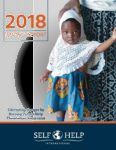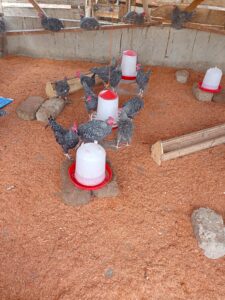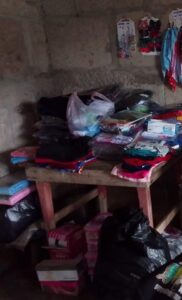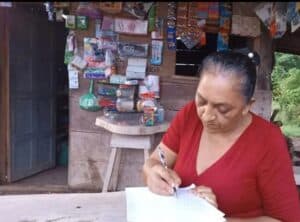
Helping Farmers to Increase Yields, Incomes, and Food Security
By Jorge Campos, Nicaragua Country Director

Nicaraguan farmers looking out at their field.
Most farmers in the world have about 40 growing seasons, or 40 chances to improve on every harvest. We recall fondly what our best yielding year was and how much that yield was. Each year, we work to move that number a little higher, whether we’re farming in Iowa or Ghana or Nicaragua.
The low-income farmers in rural Nicaragua often yield only 45 to 50 bushels of corn per acre, which is about 25% of what is considered a good yield in Iowa. For the past twenty years, my colleague Alfredo Aleman and I have been working to equip farmers with the access to technology and knowledge to make informed decisions so they can increase yields and better feed their families.
Just like in Iowa, farmers improve yields by innovating, inventing or improving topological designs. We decide whether or not to apply fertilizers, whether or not to use improved varieties, and whether to use hybrid seed or local varieties.
After more than two decades of farming, my long-time colleague, and an experienced Self-Help seed producer, Alfredo Aleman set a new goal for himself. He wanted to achieve a yield of 140 bushels per acre on his farm, triple the typical yield of a small-scale Nicaraguan farmer such as himself. In that way, he would be able to show his friends and neighbors that even when working with limited resources or machinery, still a higher yield was possible.
Together, he and I pioneered the experimentation and application of the Double Row Corn planting system at Self-Help’s Fred W. Strohbehn Training Center. Double row planting is our own invention; we designed a way to introduce 12 corn plants per linear meter, in order to obtain a population density of 120,000 plants per hectare.
By planting in this way, the producer can achieve the same yields on much less land. By employing double-row planting and improved farming techniques, farmers have higher yields on two or three well-planted acres than they do on greater acreage that’s been poorly planted. This allows farmers to save money by renting less land than they normally would.
Additionally, farmers trained in this manner learn how to be more efficient in their work. They learn to rely on family members to work the farm instead of hiring outside workers, thus decreasing their costs. And, when they plant Nutrader certified QPM seedcorn, yields are double or triple what they normally are when a farmer uses only one additional fertilizer. With the money farmers save using our improved farming techniques, they are able to reinvest in their farms and technologies and thus continue improving over time.
These impressive results showed that our innovation worked, but that was only the first step. We had to convince local farmers to try these innovations themselves. Double-row planting sounded strange, and we weren’t sure how farmers would react. We needed to show them that our method worked, so we began establishing demonstration plots. With the success of those plots, farmers realized that they didn’t need to plant huge parcels of land but could be more effective on smaller plots if they improved their methods. These plots targeted most of the small-scale farmers in the Rio San Juan, Rivas, and Ometepe Island areas. We reached these farmers by way of our seminars and training sessions – 458 attended these sessions, and ultimately 118 family farmers experimented with our demonstration plots in 2018.

Alcides planning his maize rows.
Alcides Torres Gamez, one of the first farmers who attended the double row corn planting technology training. “I remember the first time Jorge Campos from Self-Help International Nicaragua came and invited me to a training session that he was going to lead on improving corn harvest yields,” Alcides recalled. “I said to myself, ‘There is no way I’m going to that meeting.’ Believe me, I don’t like those kinds of things. But, after thinking for a little while, I decided – well, I guess I can go, and if I don’t like what I hear, I can always leave the meeting.”
Despite his hesitation, Alcides was impressed by what he was learning. “I liked hearing that my corn harvest would double if I followed the double row planting method and used proper supplies, such as pesticides, herbicides, and fertilizers,” he explained. “I decided to start implementing the double row planting method, and as a result, I got what Self-Help told me about – double the yield! From one manzana I used to get 20 to 25 quintales of corn; but with this new method, I got 45 quintales. This allowed me to sell 20 quintales, which produced a profit of US $350, and left 25 quintales for my family to eat.”
Double-row technology includes associated costs in land, inputs, family and hired labor, tools, and equipment. Initial costs per family are between $660 – $830 US per manzana ($388 – $488 per acre), with a return of roughly $1,153 per manzana ($678 per acre), even after family consumption. The economic return is greater, and the harvest ensures that the farmer can feed his family. After working with 118 families, we saw for ourselves that yields were higher – two to three times what they’d been before we intervened. It was more than we anticipated, and we were thrilled! Bit by bit, we were improving the lives of Nicaraguan family farmers.

 Previous Post
Previous Post Next Post
Next Post


